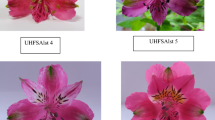Abstract
Genetic variation of resistance and tolerance to stemborer, Chilo partellus, was studied in three sorghum crosses. Parents, F1 and F2 progenies were evaluated for per cent foliar damage and stem tunnelling as a measure of resistance or susceptibility. The parental cultivars involved in the crosses represented a fairly distinct range of character expression for plant height, foliar damage, stem tunnelling, stem lodging and grain yield. Means, degrees of dominance in F1 and inbreeding depression in F2 suggested that susceptibility was dominant over resistance in crosses susceptible x resistant and susceptible x tolerant, while resistance was dominant over susceptibility in the cross tolerant x resistant. The variation patterns of foliar damage and stem tunnelling in parents, F1 and F2 progenies suggested that they are different and are independently inherited. Both resistance and tolerance mechanisms are operating in sorghum resistance to stem-borers and these mechanisms are independently inherited. Estimates of heritability (broad-sense), genetic coefficient of variation and expected genetic advance, indicated that the cross Serena (tolerant) x IS 2146 (resistant) provides maximum chances of selecting resistant and tolerant plants in the segregating populations. Recurrent selection (population breeding) is suggested to improve the level of stem-borer resistance and tolerance and yield in sorghum.
Résumé
La variation génétique de la résistance et tolérance au rongeur de tige, Chilo partellus a été étudiée dans trois croisés de sorgho. Les parents, et les descendants F1 et F2 ont été evalués quant au pourcentage de dégâts causés aux feuilles, et un creusement de tige, ceci constituant une mesure de la résistance ou de la susceptibilité. Les cultivars des parents utilisés dans le processus d’hybridation réprésentaient un large eventail de charactéristiques exprimant la hauteur des plantes, le dégât des feuilles, le creusement des tiges, et la récolte des graines. Les moyennes, les degrés de dominance dans F1 et la réduction de la reproduction interne dans F2 ont suggéré que la susceptibilité était dominante vis à vis la résistance dans les hybrides susceptible/résistant et susceptible/tolérant, alors que la résistance était dominante vis à vis la susceptibilité dans l’hybride tolérant/résistant. Les modèles de variation de dégâts des feuilles et le creusement des tiges dans les disandants des parents F1 et F2 on suggéré qu’ils sont differents et sont hérités indépendanment. Les mécanismes de tolérance et de résistance entrent tous en jeu dans la résistance du sorgho aux rongeurs de tige, et ces mécanismes sont indépendament hérités. Les estimation sur l’héritabilité (sens large) le coefficient génétique de variation l’avance génétique anticipée, ont indiqué que l’hybride Serena (tolérant) IS 2146 (résistant) donne le plus de chance de sélectionner des plantes résistantes et tolérantes dans les populations choisies. Une sélection fréquente est suggérée pour améliorer le niveau de résistance ou tolérance au rongeur de tige ainsi que la récolte du sorgho.
Similar content being viewed by others
References
Allard R. W. (1960) Principles of Plant Breeding. Wiley, New York.
Burton G. W. (1951) Quantitative inheritance in pearl millet, Pennisetum glaucum. Agron. J. 43, 409–417.
Johnson H. W., Robinson H. F. and Comstock R. E. (1955) Estimates of genetic and environmental variability in soyabeans. Agron. J. 47, 314–318.
Jotwani M. G. (1976) Host plant resistance with special reference to sorghum. Proc. natn. Acad. Sci. India 46B, 42–48.
Jotwani M. G. (1978) Investigations on insect pests of sorghum and millet with special reference to host plant resistance. Tech. Res. Bull. Div. Ent. IARI, New Delhi, India 114.
Kalode M. B. and Pant N. C. (1967) Effects of host plant on survival, development and behaviour of Chilo zonnellus (Swinhoe) under laboratory conditions. Indian J. Ent. 291, 48–57.
Lerner I. M. (1958) The Genetic Basis of Selection, pp. 57–65. Wiley, New York.
Pathak R. S. (1983) Genetics of sorghum resistance to stem borers. In Abstracts of Contributed Papers, p. 729. Paper presented at the XV International Congress on Genetics, New Delhi.
Pathak R. S. and Olela J. C. (1983) Genetics of host plant resistance in food crops with special reference to sorghum stem-borers. Insect Sci. Applic. 4, 127–134.
Rana B. S. and Murty B. R. (1971) Genetic analysis of resistance to stem-borer in sorghum. Indian J. Genet. 31, 521–529.
Rana B. S., Singh B. U. and Rao N. G. P. (1983) Genetics of stem borer resistance in sorghum. In Abstracts of Contributed Papers, p. 729. Paper presented at the XV International Congress on Genetics, New Delhi.
Author information
Authors and Affiliations
Rights and permissions
About this article
Cite this article
Pathak, R.S. Genetic Variation of Stem-Borer Resistance and Tolerance in Three Sorghum Crosses. Int J Trop Insect Sci 6, 359–364 (1985). https://doi.org/10.1017/S174275840000463X
Received:
Published:
Issue Date:
DOI: https://doi.org/10.1017/S174275840000463X
Key Words
- Resistance
- tolerance
- foliar damage
- stem tunnelling
- genetic variation
- heritability
- genetic coefficient of variation
- genetic advance
- recurrent selection



